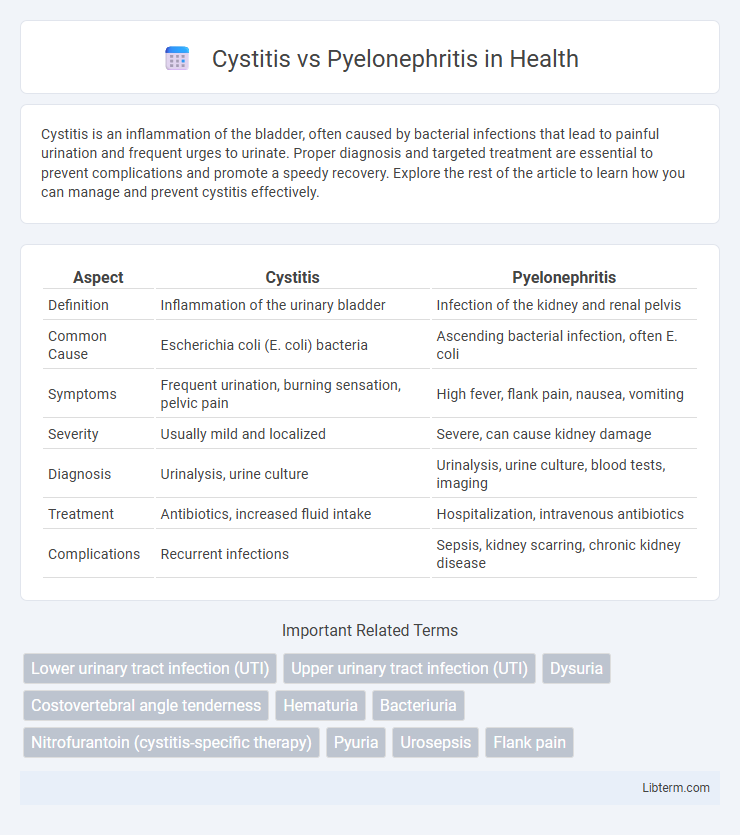Cystitis is an inflammation of the bladder, often caused by bacterial infections that lead to painful urination and frequent urges to urinate. Proper diagnosis and targeted treatment are essential to prevent complications and promote a speedy recovery. Explore the rest of the article to learn how you can manage and prevent cystitis effectively.
Table of Comparison
| Aspect | Cystitis | Pyelonephritis |
|---|---|---|
| Definition | Inflammation of the urinary bladder | Infection of the kidney and renal pelvis |
| Common Cause | Escherichia coli (E. coli) bacteria | Ascending bacterial infection, often E. coli |
| Symptoms | Frequent urination, burning sensation, pelvic pain | High fever, flank pain, nausea, vomiting |
| Severity | Usually mild and localized | Severe, can cause kidney damage |
| Diagnosis | Urinalysis, urine culture | Urinalysis, urine culture, blood tests, imaging |
| Treatment | Antibiotics, increased fluid intake | Hospitalization, intravenous antibiotics |
| Complications | Recurrent infections | Sepsis, kidney scarring, chronic kidney disease |
Introduction to Urinary Tract Infections
Urinary tract infections (UTIs) encompass a range of infections affecting different parts of the urinary system, primarily caused by bacteria such as Escherichia coli. Cystitis refers to inflammation of the bladder, manifesting symptoms including dysuria, urinary urgency, and suprapubic pain. Pyelonephritis, a more severe upper urinary tract infection, involves inflammation of the renal pelvis and kidney parenchyma, often presenting with high fever, flank pain, and systemic signs of infection.
What is Cystitis?
Cystitis is an inflammation of the bladder, commonly caused by a bacterial infection affecting the lower urinary tract. This condition presents symptoms such as frequent urination, burning sensation during urination, and pelvic discomfort. It is crucial to differentiate cystitis from pyelonephritis, which involves kidney infection and manifests more severe symptoms like fever, flank pain, and nausea.
What is Pyelonephritis?
Pyelonephritis is a severe kidney infection that typically arises from an untreated lower urinary tract infection like cystitis, involving inflammation of the renal pelvis and kidney tissue. This condition is characterized by symptoms such as high fever, flank pain, nausea, and frequent painful urination, distinguishing it from cystitis, which primarily affects the bladder. Prompt diagnosis and treatment with antibiotics are crucial to prevent complications like kidney damage or sepsis in pyelonephritis.
Causes of Cystitis and Pyelonephritis
Cystitis primarily results from bacterial infection, most commonly Escherichia coli, ascending from the urethra to the bladder due to poor hygiene, urinary catheterization, or sexual activity. Pyelonephritis occurs when the infection spreads from the bladder to the kidneys, often caused by untreated or recurrent urinary tract infections, leading to inflammation of the renal pelvis and kidney tissue. Risk factors for both include urinary tract obstructions, vesicoureteral reflux, and compromised immune systems, which facilitate bacterial proliferation and infection severity.
Symptoms: Cystitis vs Pyelonephritis
Cystitis primarily presents with symptoms such as frequent, painful urination, lower abdominal discomfort, and cloudy or strong-smelling urine. Pyelonephritis symptoms are more severe, including high fever, chills, flank pain, nausea, and vomiting, indicating kidney involvement. Differentiating these urinary tract infections clinically aids in accurate diagnosis and targeted treatment.
Diagnostic Methods for Both Conditions
Urinalysis serves as a primary diagnostic tool distinguishing cystitis from pyelonephritis by detecting bacteriuria, pyuria, and hematuria, with urine culture confirming the causative pathogen for targeted antibiotic therapy. Pyelonephritis diagnosis often requires imaging studies such as renal ultrasound or CT scan to identify renal involvement, abscesses, or obstruction, which are absent in cystitis cases. Blood tests including complete blood count (CBC) and blood cultures help evaluate systemic infection signs indicative of pyelonephritis, unlike localized cystitis infections typically limited to the bladder.
Risk Factors and Predisposing Conditions
Cystitis primarily affects the lower urinary tract and is commonly associated with risk factors such as female gender, sexual activity, urinary catheterization, and diabetes mellitus. Pyelonephritis involves the upper urinary tract and kidneys, with predisposing conditions including vesicoureteral reflux, urinary tract obstruction, and immunosuppression. Both infections share risk factors like urinary stasis and anatomical abnormalities that facilitate bacterial colonization and ascending infection.
Treatment Approaches: Cystitis vs Pyelonephritis
Treatment approaches for cystitis typically involve oral antibiotics such as nitrofurantoin or trimethoprim-sulfamethoxazole for a short duration of 3 to 7 days, aimed at resolving lower urinary tract infections. Pyelonephritis requires more aggressive treatment with intravenous antibiotics like fluoroquinolones or third-generation cephalosporins, often followed by an oral antibiotic course to address upper urinary tract infections and prevent complications. Supportive care, including hydration and pain management, is critical in both conditions but more intensive monitoring is essential in pyelonephritis due to the risk of systemic infection.
Complications and Prognosis
Cystitis primarily results in localized bladder inflammation with complications such as recurrent urinary tract infections and potential bladder scarring, generally presenting a favorable prognosis when treated promptly. Pyelonephritis involves kidney infection that can lead to severe complications including renal abscess, sepsis, and chronic kidney disease, with a prognosis heavily dependent on timely antibiotic therapy and patient comorbidities. Both conditions require early diagnosis to prevent progression, but pyelonephritis poses a higher risk for long-term renal damage and systemic complications.
Prevention Tips for Urinary Tract Infections
Maintaining proper hydration by drinking at least 8 glasses of water daily helps flush out bacteria from the urinary tract, reducing the risk of both cystitis and pyelonephritis. Practicing good hygiene, such as wiping from front to back and avoiding irritants like harsh soaps, lowers the chance of bacterial ascent leading to bladder or kidney infections. Urinating promptly after sexual activity and avoiding prolonged urinary retention prevent bacterial colonization, which is critical for preventing urinary tract infections including both cystitis and pyelonephritis.
Cystitis Infographic

 libterm.com
libterm.com